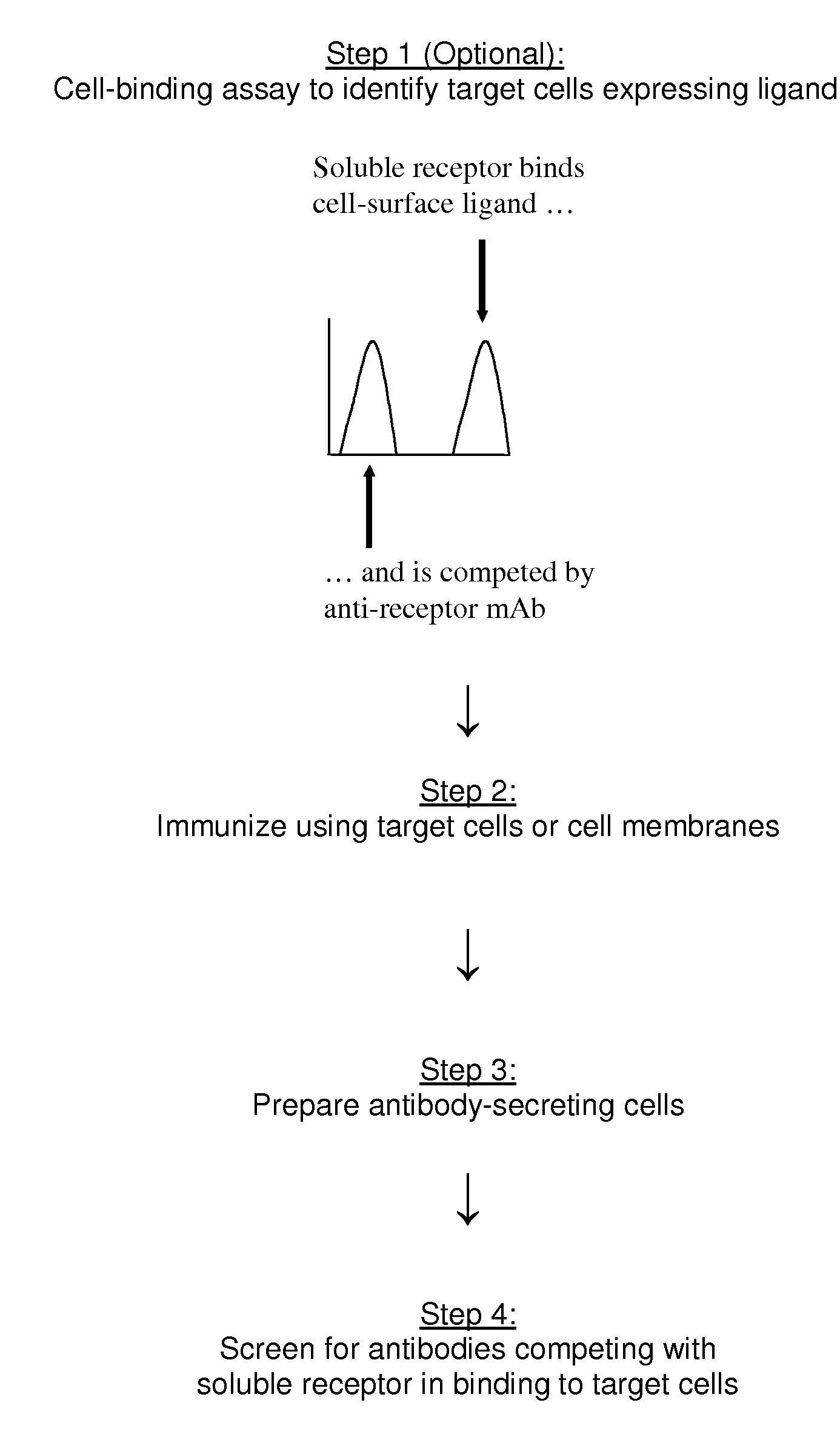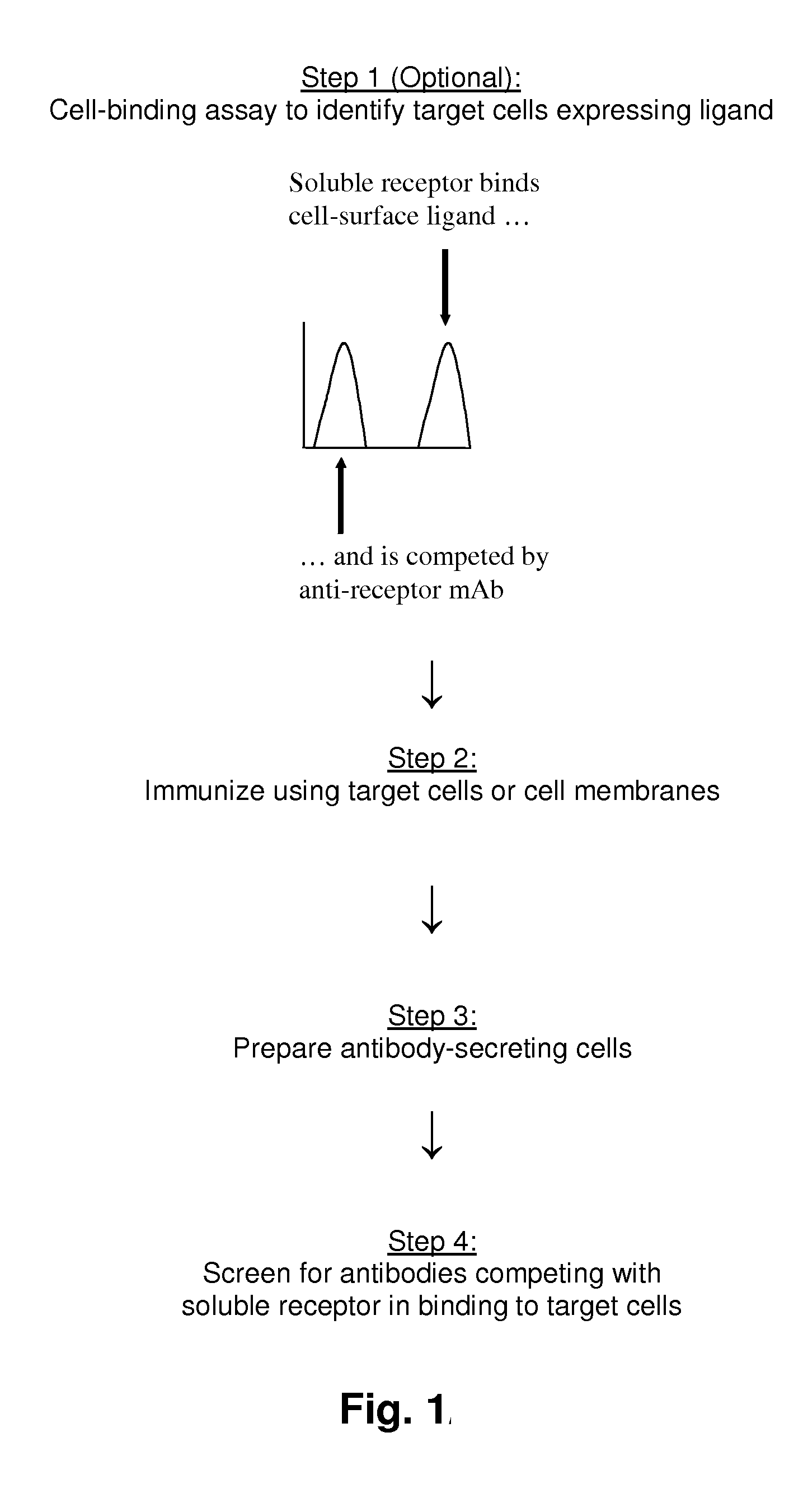Methods of Identifying Antibodies to Ligands of Orphan Receptors
a technology of orphan receptors and antibodies, which is applied in the field of identification of cell surfaceassociated ligands to orphan ligands, can solve the problems of limiting the usefulness of therapeutic applications of nk cells, killing only sick or abnormal cells, and not healthy ones,
- Summary
- Abstract
- Description
- Claims
- Application Information
AI Technical Summary
Problems solved by technology
Method used
Image
Examples
example 1
Preparation of soINKp30-FTL-Fc Construct
[0214]This examples describes the preparation of a fusion protein comprising residues 20 to 149 of the full NKp30 sequence (SEQ ID NO:1). The NKp30 portion of the construct includes residues 20-138 of SEQ ID NO:1, corresponding to an extracellular fragment of receptor; residues 139-149 from the neighboring transmembrane region, providing a flexible transmembrane (FTL) region, as well as an alanine (A) linker between the NKp30 fragment and the Fc domain. The alanine is introduced via the cloning strategy. However, glycine or another small “in-offensive” amino acid can work just as well as spacer.
[0215]Briefly, total RNA template for cDNA synthesis was purified from peripheral blood mononuclear cells (PBMC) from a healthy donor, using RNAeasy Mini Kit (Qiagen#74104) and DNasel (Sigma#AMP-D1) on-column digestion. NKp30 cDNA, encoding the mature form of NKp30 (i.e. lacking the leader-sequence) was generated by reverse transcription and polymerase ...
example 2
Identification of Cells Expressing NKp30L Using soINKp30
[0218]This example describes a cell-binding experiment using soINKp30-FTL-hFc to identify cells expressing NKp30L.
[0219]Briefly, NKp30L-expressing cell-lines were identified by flow-cytometry (FACS) by their capacity to bind soINKp30-FTL-hFc. Various tumor cell lines were incubated with fixed amounts of fluorescently labeled soINKp30-FTL-hFc (e.g. in the range of 10−2-102 μg / ml APC-soINKp30-FTL-hFc), in tissue-culture medium containing 2% FCS, for 30 minutes on ice. Cells were washed and the binding of soINKp30-FTL-hFc to cells was analyzed by flow-cytometry. Alternatively, tumor-cells were incubated with non-fluorescently labeled soINKp30-FTL-hFc, washed, and incubated with fluorescently-labeled secondary antibodies specific for human IgG Fc, washed, and analyzed by flow-cytometry. In both assays, soINKp30-FTL-hFc binding to cells was determined by analyzing the mean-fluorescence bound to individual cells, in comparison with t...
example 3
Comparative Cell-Binding of Different soINKp30-Fc Constructs
[0221]This example describes an experiment designed to compare the cell-binding capabilities of soINKp30-FTL-Fc and the commercially available 1849-NK construct. As shown in FIG. 6, the 1849-NK construct has an N-terminal leucine which is absent from soINKp30-FTL-Fc, and has a different sequence between the extracellular part of NKp30 and human IgG1 Fc; in this region 1849-NK lacks an FTL but instead contains a different, shorter linker sequence.
[0222]Briefly, soINKp30-FTL-Fc or 1849-NK proteins (20 ug / ml) were incubated with K562 cells for 45 min on ice. The cells were washed, and incubated with a 1:50 dilution of APC-conjugated Fab′2 donkey anti-human Fc (Jackson Immunoresearch Cat#: 709-136-149) for 30 min on ice. After washing the cells were analyzed by flow cytometry.
[0223]As shown in FIG. 4, soINKp30-FTL-Fc had improved binding characteristics over 1849-NK, since it resulted in much stronger fluorescence (x-axis in FI...
PUM
| Property | Measurement | Unit |
|---|---|---|
| pH | aaaaa | aaaaa |
| decay energy | aaaaa | aaaaa |
| decay energy | aaaaa | aaaaa |
Abstract
Description
Claims
Application Information
 Login to View More
Login to View More - R&D
- Intellectual Property
- Life Sciences
- Materials
- Tech Scout
- Unparalleled Data Quality
- Higher Quality Content
- 60% Fewer Hallucinations
Browse by: Latest US Patents, China's latest patents, Technical Efficacy Thesaurus, Application Domain, Technology Topic, Popular Technical Reports.
© 2025 PatSnap. All rights reserved.Legal|Privacy policy|Modern Slavery Act Transparency Statement|Sitemap|About US| Contact US: help@patsnap.com



